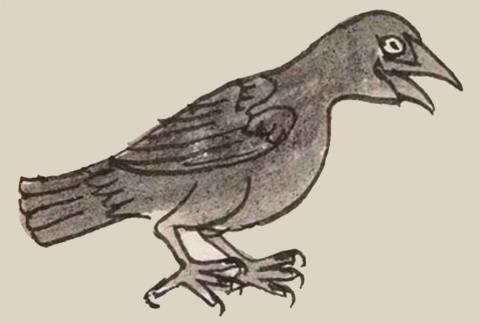cacalotl (Mdz33r)
The crow (cacalotl) is shown here in profile, in its full size, facing to our right. It should be colored gray, with a gray beak, feet, and a light gray eye. Its beak is slightly open, but it does not have the hook on the top part of the beak that an eagle has, for instance. But, like the eagle, the claws are fairly prominent. The compound glyph in which this element appears has a hand-arm (maitl or matl) above the cacalotl, and the place name it represents is Cacalomacan (with the locative -can not being shown visually).
Stephanie Wood
Cacalotl was a name that could be given to a person. There was a prominent Nahua leader in Cuauhtlantzinco (now in the state of Puebla) named Cacalotl. He is the fourth figure on the left in this scene from the Mapa de Cuauhtlantzinco (19th-century copy of an earlier pictorial manuscript), https://mapas.wired-humanities.org/cuauh/elements/cuauh01/000.
Stephanie Wood
c. 1541, or by 1553 at the latest
Stephanie Wood
Joseph Scott and Crystal Boulton-Scott made the SVG.
bird, birds, crows, ave, aves, pájaro, pájaros, pluma, plumas, animals, animales

cacalo(tl), crow, https://nahuatl.wired-humanities.org/content/cacalotl
a crow
el cuervo
Stephanie Wood
Codex Mendoza folio 33 recto, https://digital.bodleian.ox.ac.uk/objects/2fea788e-2aa2-4f08-b6d9-648c00..., image 76 of 188.
The Bodleian Libraries, University of Oxford, hold the original manuscript, the MS. Arch. Selden. A. 1. This image is published here under the UK Creative Commons, “Attribution-NonCommercial-ShareAlike 3.0 License” (CC-BY-NC-SA 3.0).


